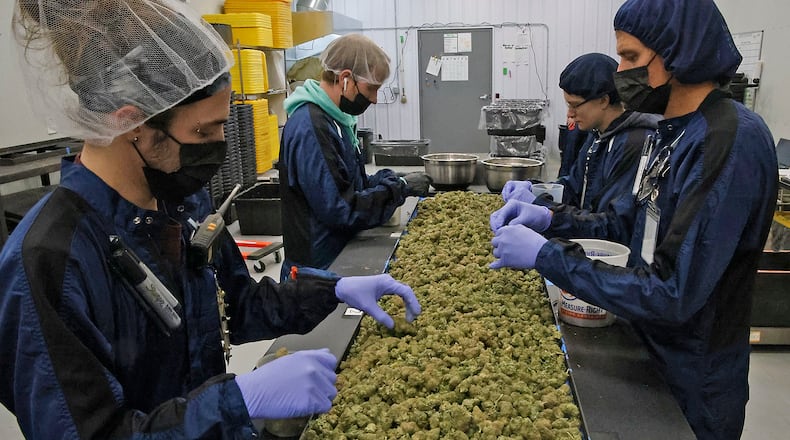Recreational possession was legalized by Issue 2 by a strong majority of Ohio voters. But recreational dispensary licenses are still months away from being issued. The Ohio Senate and Gov. Mike DeWine hope to open that gate early by allowing medical dispensaries to sell directly to any customer 21 years old or older.
The operators of Pure Ohio Wellness say they are ready.
This news organization took a tour of Pure Ohio Wellness’ cultivation site to provide readers with insight as to how commercial marijuana is grown in Ohio and what of-age Ohioans can expect to see in dispensaries as Issue 2 and its reforms move forward.
Step 1: Propagation from a mother plant
Credit: Bill Lackey
Credit: Bill Lackey
The process begins in what is called the “mom room” — a space filled with dozens of carefully selected, mature female cannabis plants of all different strains. These mother plants are the start of thousands of crops Pure Ohio Wellness produces each year.
“Everything that we do comes from cloning these plants. That’s how the stock keeps going,” said Pure Ohio Wellness COO Tracey McMillin who, on this occasion, also acted as tour guide.
In a process that houseplant caretakers might recognize as propagation, workers will cut off shoots from the mother plant, which are then transported into an aeroponic device that uses water and oxygen to encourage those offshoots to grow roots.
In effect, the process clones the mother plant hundreds of times and keeps the best attributes from well-performing plants. After a certain point, the mother plants get rotated out and destroyed.
This point is also where the state-mandated “seed to sale” tracking system begins, as most cannabis plants in Ohio are not originated from seed but instead by propagation.
Step 2: Cloning
In another room, there’s about 4,500 propagations sitting in “aeroponic cloners” where they grow their roots and get ready to be potted. The system is highly controlled; there’s an exact amount of light, temperature, water acidity and nutrient content that yields best results.
Head of Cultivation Cody Neidig said Pure Ohio Wellness is one of few facilities in the state to move over to an aeroponic system. Most others use what’s called a “rock wool” approach to cloning, which places propagations immediately into a soil-like medium while they grow their roots.
After 18 days in the cloning stage, propagations will have grown about eight inches tall and have the roots to match before being planted into soil.
Step 3: Vegetative Stage
Cannabis plants can be manipulated by the amount of light they receive. In the vegetative state, in which Pure Ohio Wellness exposes the plants to 18 hours of light and only six hours of darkness, the plant is tricked into believing it’s summer and puts all of its energy into sinking its roots into the soil and growing tall.
Cannabis plants sit in this stage for about 21 days, growing up to around six feet tall.
Step 4: Flowering Stage
The flowering stage is ultimately the crux of Pure Ohio Wellness’ operation. As cultivators passionate about the plant, it’s also the stage that seemed to bring the most excitement out of the employees.
Up until this point, there’s nothing on the plant that is particularly consumable. But, by reducing the amount of light the plant receives from 18 hours to 12, the plant can be manipulated to begin flowering and producing what is commonly referred to as bud, which is where THC, the cannabinoid that is most responsible for making people feel high, actually emanates from.
THC content levels in bud — regulated by the state at a maximum of 35% — is largely determined by strain of marijuana you’re growing and the THC content produced by the mother plant. But, in highly controlled environments like Pure Ohio Wellness’, THC content can also be impacted by too much or too little sunlight, carbon dioxide or other nutrients a plant receives.
“It’s a delicate balance, you really have to get to know them,” said Korinne Kirkmeyer, a Pure Ohio Wellness employee who cares for the cannabis plants while they’re in the flowering stage.
The flowering stage is also where the various strains really begin to distinguish themselves.
Some flowers are markedly different from others, showing hues of purple or orange with various levels of trichomes — a nearly microscopic, crystal-like formation full of THC that gives bud the look of being frosted. (Generally, the more trichomes a plant produces, the higher-end the plant is.)
Some plants’ flower also produces unique smells that are important enough to buyers that it factors in highly to Neidig and McMillin’s decision of what strains to grow.
“Whenever we pick out strains, we try to get something that yields well, and that has high THC, and that has a great smell to it,” Neidig said. “Basically, those are our three best criteria and then after that it becomes (about) how easy it is to work with.”
After 54 days of the new light regiment, the cannabis plant will have produced its maximum amount of flower and be ready for harvesting.
Step 5: Harvest
Over the course of a week, the flowered plants are left to dry up the remaining water in the soil (a room full of plants can weigh 6,000 lbs wet and 3,000 lbs dry) before being harvested by hand.
Through its coordinated levels of control over the plants and calculated planning, Pure Ohio Wellness can harvest once a week in various different rooms. Each harvest, depending on the strain, can produce anywhere from 150 to 450 pounds of marijuana.
But, in the industry, a plant’s yield is measured in grams per square foot. Some can produce up to 90 grams per square foot while others produce around 65. But, that lower-yield plant can be more profitable to the cultivator if it’s a higher THC content and can be sold at a premium.
“We’d rather have high quality than something that just yields a ton,” Neidig said.
Most of the harvest is transported directly to a trimming center for the purposes of just being sold as bud, but some of it is quickly frozen in-house and turned into a rosin, commonly known as dabs, that has much higher THC content than standard flower. Some is also processed through a smaller operation elsewhere in the facility to create oils for vape cartridges.
Step 6: Post-harvest: Trim, Cure, Package, Test, Quality Control
Once a harvest is taken in, the flower is trimmed over the course of a week, give or take, by a group of workers to remove leaves and stems. The trimmed flower is then moved to a curing room, where it sits by the barreful for 30 days to evenly dry out. After that, the flower is transported to the facility’s packaging center, which weighs out the flower into various different containers.
Once packaging is complete, a small portion of each batch of product gets tested by the state for its THC content and for pesticides or other harmful substances while the rest of the batch moves through Pure Ohio Wellness’ quality control check to ensure that bud doesn’t have excess amounts of stems or leaves.
“It’s really making sure that only product we’re happy with is being sold,” Neidig said.
Step 7: Sales to dispensaries
Once finished, Pure Ohio Wellness’ products are sold in dispensaries throughout the state.
The company doesn’t grow to order, but instead sells each batch wholesale to dispensary partners across the state when it’s ready to move.
The company also runs its own dispensaries in Dayton and London. Company officials say the process outlined above can be scaled up to meet demand for recreational marijuana. The company and its owner Larry Pegram — a retired motorcycle racer from the Columbus area — spent hundreds of thousands of dollars in support of Issue 2.
“I think the faster we can give people what they asked for when they voted, I think the better off it is for everyone. We will do what we have to do to adjust,” McMillin said.
About the Author










